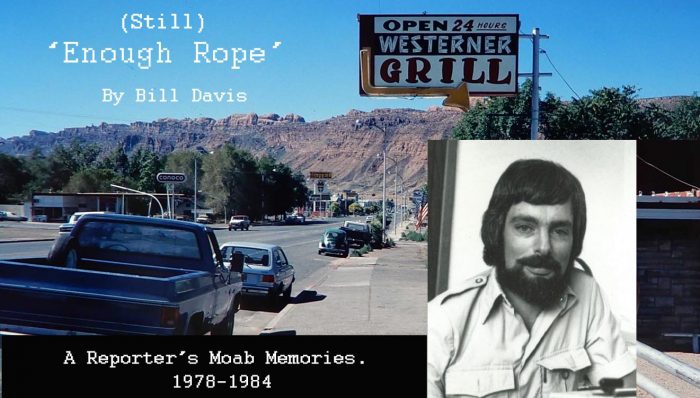
My first controversy on the paper was one I didn’t seek and didn’t want, especially so early in my tenure; I had only been reporting for a couple of months.
The issue involved the Friendship Cruise between Green River and Moab, which continued to exist, so at least I didn’t destroy it, but I was certainly accused of torpedoing the 1978 version, right after arriving in town, too.
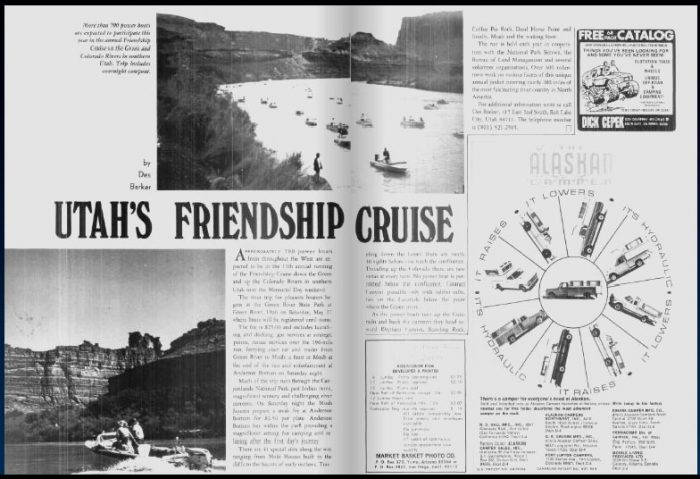
Actually, I suppose it was less of a torpedo attack than a slow leak in a through-hull fitting, irritating but survivable. To further mix metaphors, what I torpedoed was a sacred cow, and I had a pretty good idea it was so at the time.
I sort of accidentally told the truth.
The June event started at the Green River put-in, proceeded down the Green through Stillwater and Labyrinth canyons, turned left at The Confluence, and headed against the current up the Colorado to the Moab takeout. Total distance of the cruise was 184 miles.
And children, I will tell you right now 184 miles is a long goddamn way to sit in a motorboat. Especially with people you don’t know, although they were certainly nice enough, and did, in truth, haul me and my equipment a very long way without recompense. So thanks again Sinclair Thompson and Gordon Moreshead. I doubt they suspected what would result from transporting a reporter. Certainly I didn’t.
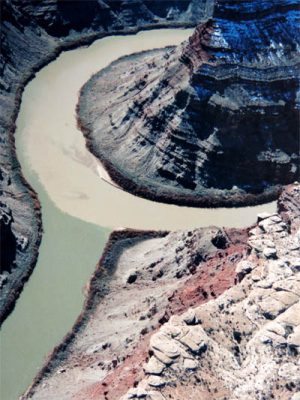
For those familiar with the area, a comparative experience to the cruise distance-wise would involve sitting on a lawn chair in the back of a pickup truck driving from Moab to Spanish Fork at something around 20 mph. Not impossible, but—long, even when split into two days.
However, the counterpoint was the close-up, if superficial, look at some of the most spectacular scenery in Canyonlands, in an area difficult to reach without a lengthy hike or 4X4 trip around the White Rim (a trip I grew to love because you could go two days without seeing anyone, with no permits required or bikes to block the view.) I jumped at the chance to go on the Cruise, figuring it would be a good survey of the countryside, covering areas one could spend a lifetime exploring.
And those canyons–such unutterable beauty as to fuse your eyeballs. Soaring orange and red cliffs merged with that impossibly blue/black sky the area frequently gets—the kind of sky you’d swear you could fall into. The cliffs alternated with occasional lush green bottoms, including the overnight site on the Maze side of the river at Anderson Bottom. I could have stayed there forever, minus the crowd, of course.
Aside from the overwhelming beauty, however, the overall impression of the event one got was of a whole lot of people heading downriver who, like me, didn’t know quite what they were getting into.
I wouldn’t be the first person to suggest that a river is different from a lake, and requires additional helming skills many boaters don’t possess (For reference, see Mark Twain’s “Life on the Mississippi.”) To start with, a surprising number of boaters ran aground on sandbars shortly below the Green River put-in.
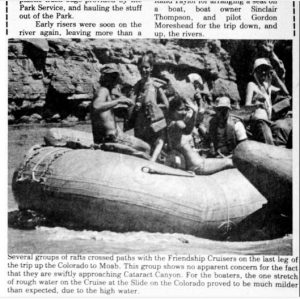
I didn’t mean to be overly critical in the article, either, as I liked boats, and knew a bit about them, having grown up sailing on the ocean with my folks in a series of small, ancient wooden sailboats (including my favorite, a 1930’s-era 32-foot ketch, which, my father said when he bought it in San Diego, was “being held up by the mooring lines.”). But there was something about the Cruise that seemed a bit off.
In ocean sailing you ascertained the best angle to the wind and stayed on that tack until you got tired of it or the wine ran out. Depth, ranging from dozens to hundreds of feet, wasn’t an issue until you tried to enter Santa Barbara’s notoriously silted-in harbor. River running is different, especially at high water on the Colorado side, where the river serves as Nature’s own toilet (sorry, poets), flushing everything downstream: logs, cows, and other things involving sheriff’s office recovery teams. Bottom features also tend to shift.
I later got tweaked a bit by a letter to the editor from a participant who insisted, among other things, that my description of an accident was in error, as there were no rocks in that stretch of the Green. Fair enough; I will offer a correction 40 years in the making: One of the boats apparently struck, at speed, a large, dark, unidentified, apparently geologic object about a third of the way out from the western shore, catapulting pilot and passenger through the windshield. I will confess, I did not actually see the collision; however, I noted one of the victims had a bloody towel wrapped around his head, and the bow was crumpled badly enough to show daylight between the deck and hull. If that didn’t involve a rock, it’ll do until another explanation comes along.
He also stated I had implied the Cruise was “fraught with danger.” Not with danger, no, but definitely fraught—with the lack of apprehension perhaps. Was the article snarky? Well, yeah, it looks that way from a distance. But was it true? Yep. Complete? That’s what’s open for discussion.
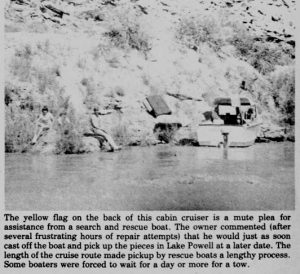
This naturally leads (doesn’t it?) into an analysis of the role of a community newspaper or other local news medium , “community” in this case meaning “small.” What it boils down to is whose truth, and how much of it?
Practitioners and consumers have wrestled for eons over what a news outlet is and is not, what it should do and should not. One of the main lines of battle is between those who favor boosterism as opposed to news. Many readers, and even more local officials, sometimes loudly wonder why the newspaper “only writes about bad things. Why don’t you support the community?”
The easy answer is we do. Much of the news is quiet but positive: James Smith receives his Eagle Scout award; Susan Sagebrush and Randy Redrock marry; new city council members are sworn in. I wrote hundreds of those stories, and hundreds more city council and county commission (back when those existed) meetings—the meat of the paper. People, however, tend to forget those stories, or ignore them because they are quiet.
But for some more civic-minded folks, that’s not sufficient; they want puff pieces about local events: inoffensive, supportive, and dull. Some would even prefer a newspaper that contains only good news, an experiment that has failed pretty much every time it has been tried (and it’s been tried a lot).
Although I hated puff pieces with a passion, I knew what would end up in most papers, a relatively harmless piece heavy on the photos, describing the delights of the trip. I was okay with that; after all, that’s what I expected. However, as the event developed and daylight turned to darkness at the Anderson Bottom overnight stop, some issues became apparent.
First, lots of these people were inexperienced in river navigation; the number of groundings was surprising. Two, some tended to underestimate gas use by a wide margin (The article pointed out a number of participants circulated at the overnight stop offering “amazing” amounts of money for gas, once they found out none was officially available at Anderson Bottom, despite being specified in the Cruise information.) Three: many mechanical breakdowns occurred, although boaters had been advised to carry a spare prop and sheer pins—good advice for operating in shallow water. These were observations, rather than criticism. Fourth: an awful lot of booze was being passed around, culminating in an overnight party that ran “long, loud, and late,” as I commented in the article. I also mentioned a group of guys who tore limbs off some of the trees to feed a bonfire. In a national park yet.
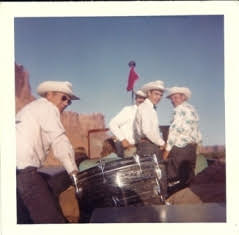
That, admittedly, is both opinion and factual observation. It also might be on the hypocritical side, considering I had just spent a year and a half playing long, loud, and late for a living, an experience that soured me on bars for life (Apparently; it hasn’t lessened any yet and I just turned 70). However, we did so in natural, appropriate spots—worn-down seedy clubs in small towns, not in a park where quiet is a major attraction.
During the evening, I collected quotes from participants, and was surprised to find most of them were negative. It might have been just the luck of my selection, but every person I talked to, with one exception, had a critical comment.
Quotes in the article included:
“’I’m never coming again. I’m sticking to Lake Powell from now on.,’ said one California man. Other out-of-staters in the vicinity nodded agreement.
“A Colorado woman with a low opinion of rivers stated, ‘They shouldn’t allow women on the trip. If Powell had had women on his trip he never would have discovered the Colorado River. I want to go home!’”’—The Times-Independent, June 1, 1978 (She really did say that.)
I also quoted one boater, who, after several hours attempting repairs, allowed as how he was ready to cast off the boat and pick up the pieces later in Lake Powell.
These were not rousing endorsements.
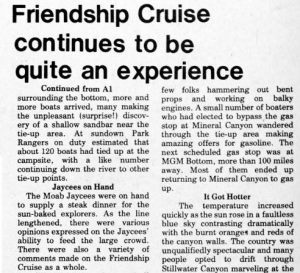
The one positive comment I dutifully collected and included was made by an older fellow consuming his Moab Jaycee steak: “Anyone who doesn’t love this is nuts!”
When I awoke after a night that was short and noisy, I noted daybreak found “a few hardy souls washing down the Jaycee-provided breakfast with more beer.” This was not exactly a puff piece.
The following day proceeded more smoothly, although one ran across the phenomenon common to upstream running. When one looked at the water rushing by, the boat appeared to be proceeding rapidly. However, checking progress by watching the bank indicated a walking speed. This was particularly disconcerting after one long day of boating, and with over 100 miles remaining to roar slowly upstream to Moab.
Oddly, or perhaps understandably, my memories of that day are fragmentary and blurred. All for the best, I imagine.
In any case, that’s what I had: a long, frequently lovely trip with some distinctly negative aspects. So, what would you do? And hurry up; you’ve only got an hour or so to write it up Monday morning.
As I told my college students for a couple of decades, the one thing a journalist has to offer is a reputation for accuracy. If that reputation ever departs, you’re useless as a reporter, and you’ll have the devil’s own time recovering it. I was just establishing myself, and I wanted townspeople to feel they could continue to trust what they saw in the paper, even when produced by the new guy. For good or ill, I decided, it would by God be accurate. After all, a reporter serves as a representative of the paper’s readers; we try to be there when they cannot.
Before I wrote the piece Monday, I kicked things around with Sam, knowing the story would probably stir up a row, especially with the Cruise organizers and the Jaycees, for whom the event was a major money raiser. I wasn’t anxious to start out this way, but I was either a reporter or I was not.
“Write what you saw and what you heard,” said Sam, to his credit and my everlasting gratitude.
So I did.
You can take a look, if you want to use your own judgment: “Friendship Cruise Continues to be Quite an Experience“, appearing in the June 1st, 1978 Moab Times-Independent.

Author’s note: This link is to the University of Utah’s Marriott Library Utah Digital Newspaper Collection, a miraculous, searchable data base of all the newspapers in Utah, including The Times-Independent and the Grand Valley Times. I am grateful to the university and the papers, as the collection has allowed me to revive old memories “Before the Colors Fade,” as Harry Reasoner titled his autobiography.
A couple of issues later, following some critical letters to the editor, Sam defended the story and the new reporter in his column, discussed the issue of puff pieces, how frequently they are run, and how widespread the practice is.
He also said I had been instructed to “tell it like it was,” which was true.
“When I saw the copy,” Sam continued, “I knew that it would be a long time before he’d be invited to ride along as a news guest on another Friendship Cruise, but saw very little exaggeration nor inaccurate reporting in his analysis of the event.
“And as I predicted, reaction from some quarters has been quite negative. So be it. Not everything in this world is all sunshine and light, and we might as well face it. There are, and have always been, some quite negative factors about the man-killing Friendship Cruise which has sapped the community spirit from more enthusiastic civic workers in the past twenty years than any other event I can think of. Don’t take my word for it, ask anyone who has spent a full three-year term on the CCRMA Board of Directors, and they’ll tell you it is a relief to have the stint behind them.”
Sam also commented that the positive aspects of the Cruise “far outweigh the negative,” adding that he believed the event should continue.
“There has to be room for improvement, though,” he added “and directors should take the negative comments as advice, rather than reflecting defensively and stating that all’s well.
“In the meantime, we’re going to make a better attempt in the future to tell it like it is (or was).” — The Times-Independent, June 8, 1978
Sam had spent a three-year term on the Cruise board of directors?
I did not know that.
Still, it was just the sort of backing a reporter hopes to receive from his or her editor. As I was to learn again and again: Sooner or later you’re going to piss off everyone in town at least once if you’re doing the job right, and it’s nice to have someone in your corner, especially if he is responsible for future employment decisions.
Just to put a polish on the whole thing, the article included what could be described as a fustercluck (a new and lesser version of the original I just invented—appropriate for, say, heavy traffic. Feel free to experiment.) with moving and parking the participants’ rigs, mentioning the massive traffic jam at the pull-outs. Rigs and trailers had traditionally been shuttled from Green River to Moab by local volunteers.
A Cruise-related story on the topic was recounted by friend Christopher Allen, who, sometime around 1973, volunteered with other locals in the moving of participants’ vehicles and trailers from Green River to Moab.
As Chris tells it: “Andrea (who was doing something for the cruise) asked if I would be willing to drive one or more vehicles down to the Potash haul-out. This was late in the day and most cruisers had been reunited with their vehicles.
“Arriving at dusk, I waited for about 30 minutes before the boat appeared and another 45 minutes helping the well-lubricated crew wrestle the Bayliner onto the trailer. They piled into the car, and though there was room, they advised me through much spittle that they didn’t know me well enough to give me a ride back.
“Many were the epithets formulated and discarded as insufficiently vile while I watched the receding taillights.”
So I wasn’t alone in interesting Cruise experiences.
As Sam had pointed out in his column, I wasn’t likely to (and didn’t ever) receive another invitation to cover the Cruise. I have so far managed to control my disappointment.
Afterword: One the best Cruise-related stories I was told (and I can’t vouch for it, but it sure should be true) involved a motorboat race associated with the Cruise years back, following the same route. I was told an over-enthusiastic competitor failed to make the one navigational decision needed during the voyage: Turn left at the Confluence of the Green and Colorado rivers. He reportedly turned right toward Cataract Canyon and entered Brown Betty Rapid at over 100 miles per hour. Bet that would wake your ass right up. He lived, according to the story.
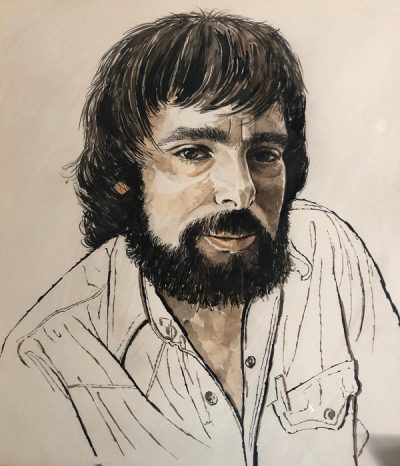
Los Angeles-born BILL DAVIS first came to Utah as a student, where he earned his Bachelor’s degree in Journalism from Utah State University. He spent his wayward youth working as a graphic cameraman and photographer, then as a musician. In 1978, Bill was hired as a reporter/columnist for Moab’s Times-Independent Newspaper before returning to USU with his wife Kris and gaining his Masters Degree. He taught Journalism at San Joaquin Delta College in Stockton, CA for 24 years, until his retirement in 2010. Now he and Kris live in Reno, NV.
To comment, scroll to the bottom of the page.
Zephyr Policy: REAL NAMES ONLY on Comments!
Don’t forget the Zephyr ads! All links are hot!
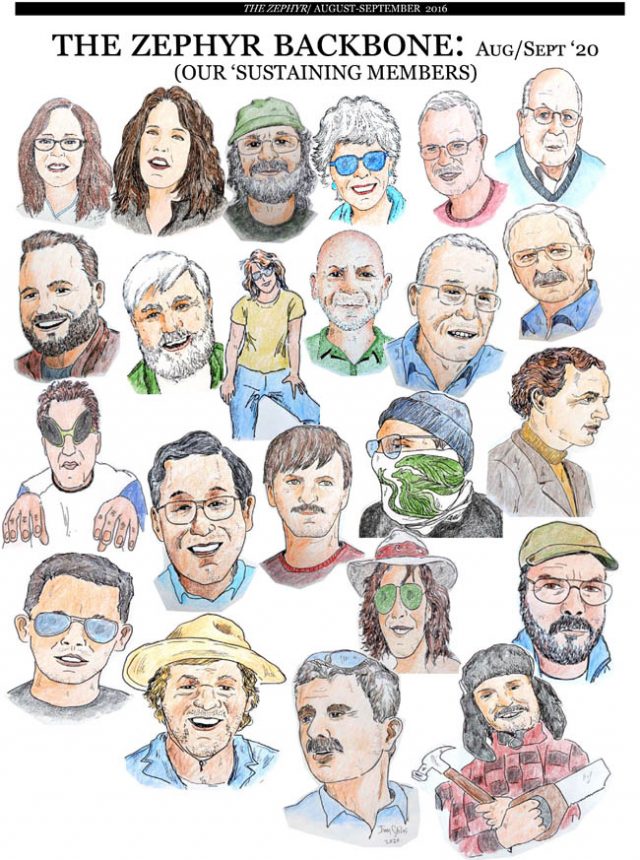
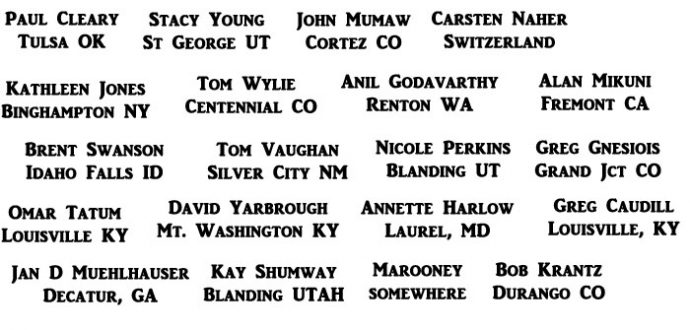


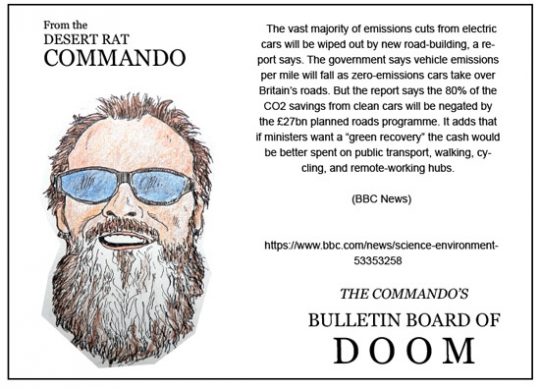
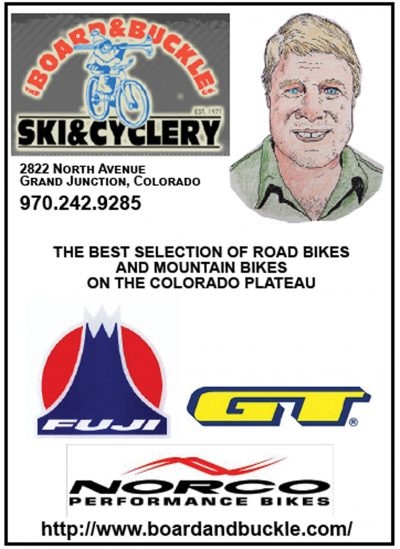

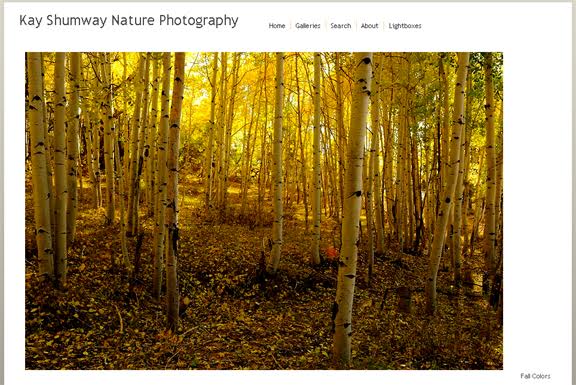
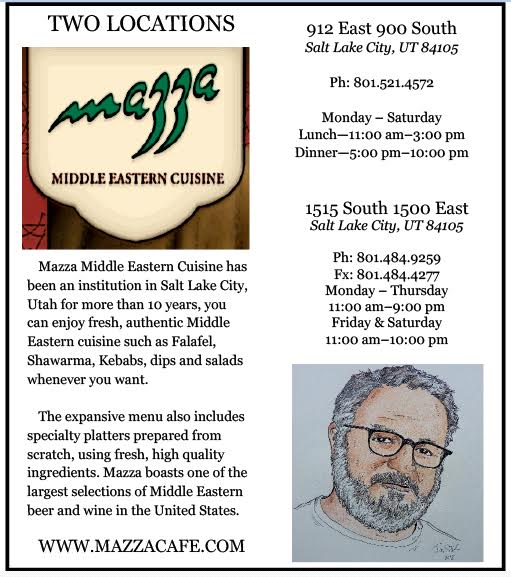

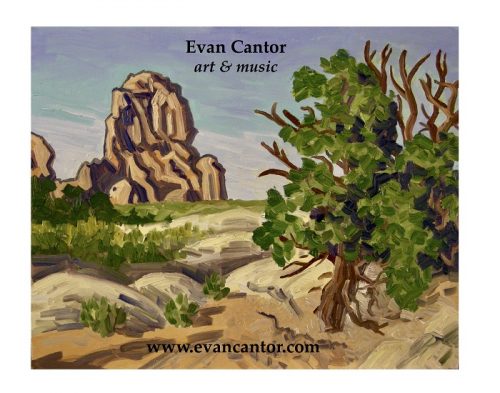
Having had the ill-considered idea to run the Green and Cataract Canyon during high water in 1991, I was offered a glimpse into the “joys” of the Friendship Cruise. There were a lot of folks with broken/grounded boats. Campsites from Mineral Bottom down to Horse Canyon were trashed. As a kayaker and rafter, you can imagine what I thought.
Great article.